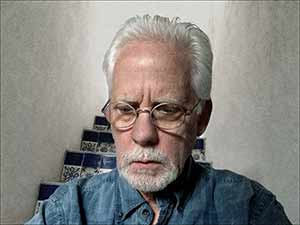 |
|
PHILOSOPHY
Don Bergland's art is an alchemical adventure into the mysteries of his own philosophy, beliefs, and values. For him, studio practise is an intellectual activity, both on his part as the creator, and on the part of the viewer as translator of the experience. As a result, he tries to place mental inquiry at the heart of each image he creates. Each work is to be studied, pondered, and deciphered by the viewer. He consciously places symbolic interactions and connections within the objects populating his theatrical sets, and encourages viewers to build their own narrative interpretations of these connections. |
He constructs his artwork like theatrical presentations. The actors in each visual set interact with and perform for the viewer. Through the stylistic use of realism, exaggeration, subdued colors, and strong lighting and shadow, Don attempts to arrange the actors in a way that connects a pivotal object or theme with object association, symbolism, and metaphor, drawing background technique from Baroque and Victorian art. For him, the enclosed space of the visual image is a dramatic cerebral theatre populated by realistic sets, objects, and figures which when combined with intention, offer challenging mental enigmas.

Walking a thin tightrope between the obvious and the absurd, Don constructs sets which host small dynamic dramas based on the mind’s ability to build meaningful narratives from enigmatic sources. The resulting images are to be seen for what they are, and then for what they may not be. Although he arranges his objects in specific ways to express his own ideas, he is fully aware that the way the imagery is designed will lead to a multitude of different interpretations. For the careful observer, directional maps are suggested in each image. These maps are woven into the location, pictorial relationship, and surface appearance of the actors in each composition. He intends that the viewer will engage with the work, note surfaces, relationships, symbols, and metaphors, and will then construct personal meaning from the engagement. Like all studio-based languages of imaginative possibility, Don has merely begun the journey of building and refining his own visual syntax and grammar of cerebral imagination. Each of his works is a record of that journey.
CAREER & ACCOMPLISHMENTS
Don Bergland is an Associate Professor Emeritus of Digital Art Education at the University of Victoria and has been an active exhibiting artist for over 50 years. During that time, he has worked through a variety of professional media, from oil on canvas to his current studio use of digital tools and techniques. He maintains an active international exhibiting career and has featured his artwork in over 160 major exhibitions throughout the world.

Don has won over 70 creative & professional awards for his work which is represented in major corporate and private collections such as the Gulf Oil Corporate Collection (Alberta), the Madrona Centre Permanent Collection (B.C.), the Canadian Utilities Corporate Collection (Alberta), the Timothy Eaton Foundation Collection (Canada), the Chevron Standard Corporate Collection (Alberta), as well as in private collections in Canada, the United States, and Europe. He has published 8 books dealing with art and creative activity, as well as published dozens of articles in scholarly and academic journals. His current studio focus is in using 3D modeling environments to create surrealistic imagery for international exhibitions. He currently lives and teach in Victoria, BC, Canada.
Further explorations of professional activity can be found at his BLOG (Link)
Or as documented daily studio activity on his Facebook Page (Link)
STATEMENT
Don Bergland describes his current work as a version of Neosurrealism with the objective of eliciting questioning attitudes in the mind of viewers. He creates his work using both traditional and digital tools, focusing on an integration of 3D modeling software and various graphic processing programs. Each of his artworks features a theatrical set defined by a stage with actors, props, and a backdrop. The actors in the set consist of everyday objects brought into combinations and interactions that attempt to elicit inquiry. The content of the artwork focuses on themes such as time, aging, nostalgia, the footless pursuit of Utopia, and the conditions of ideology which disable our rational minds.

Each image is constructed using conventions of visual realism, but with alterations that offer dreamlike possibilities. Themes and objects appear and re-appear from image to image. Each artwork becomes a framed snapshot of a moment in theatrical space, noticed briefly, and then forgotten once more, a fraction of time when reality is breached and a frozen glimpse into the mental theatre of Eternity is experienced, an opening when the viewer can catch the faint hint of cotton candy breezing in from the sideshow midway, the pastel moment of a lost memory, a slight reminder that the past is never absent, and that the future is always in front of us.
|

